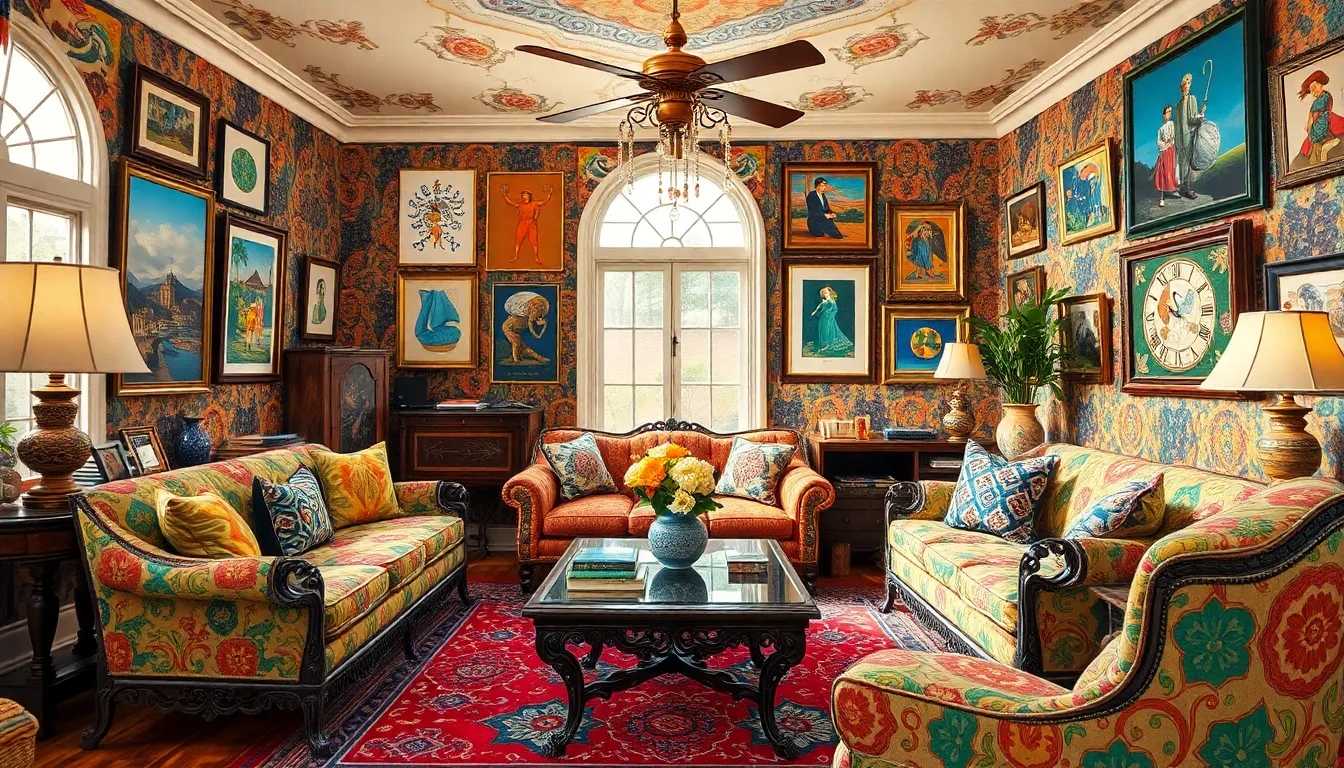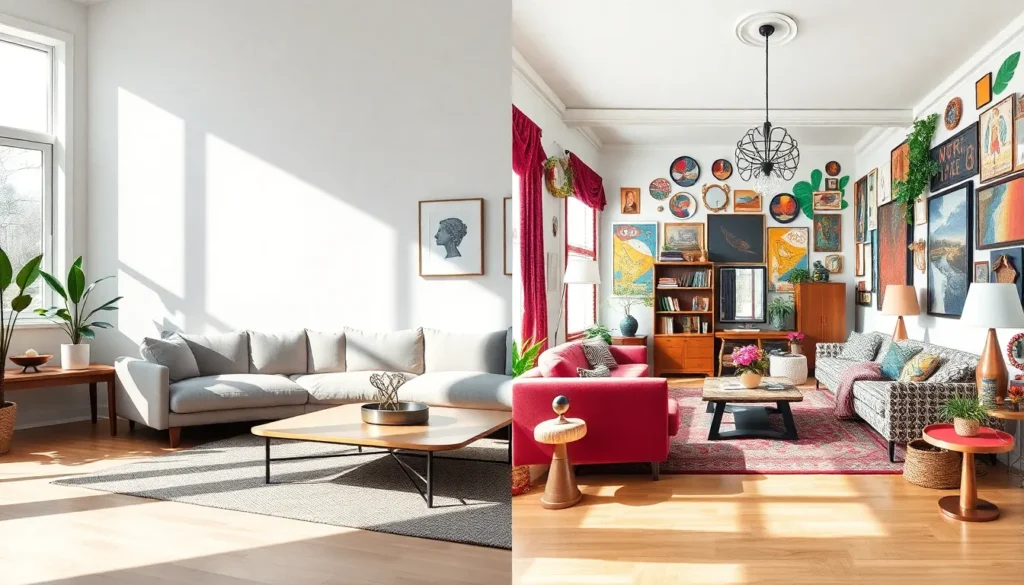In a world buzzing with choices, two design philosophies stand out like cats and dogs at a pet show: minimalism and maximalism. Minimalism whispers sweet nothings about simplicity and serenity, while maximalism throws a vibrant party, insisting that more is indeed more. Each style has its devout followers, and the debate rages on—like a never-ending tug-of-war between a zen monk and a flamboyant peacock.
So, which camp should you join? If you crave a clutter-free sanctuary where your mind can breathe, minimalism might be your jam. But if you thrive on bold colors and eclectic treasures, maximalism could be your ticket to paradise. Buckle up as we dive into the quirks and charms of these contrasting worlds, helping you decide whether to embrace the art of less or go all out with the art of excess.
Minimalism VS Maximalism
Minimalism embodies a design philosophy centered on simplicity and purpose. It emphasizes the beauty of fewer elements, promoting a tranquil and clutter-free environment.
Definition and Principles
Minimalism focuses on essential elements, stripping away non-essentials. This approach fosters a sense of calm and order in living spaces. Key principles include functionality, clean lines, and neutral color palettes. A goal of minimalism involves reducing distractions, which enhances mental clarity. Each item in a minimalist space serves a specific purpose, contributing to an overall harmonious aesthetic.
History and Evolution
Minimalism emerged as a response to the excess of previous design movements. Influences from the 20th century include artists like Piet Mondrian and architects like Ludwig Mies van der Rohe. In the 1960s and 70s, minimalism gained momentum in both art and design, emphasizing simplicity and abstraction. Over time, this movement evolved, impacting various fields such as architecture, product design, and even lifestyle choices. Contemporary minimalism has expanded into various interpretations, attracting individuals seeking simplicity in their daily lives.
Exploring Maximalism

Maximalism embraces boldness and abundance. This design philosophy thrives on vibrant colors, intricate patterns, and a diverse mix of elements.
Definition and Principles
Maximalism centers on the idea that more can indeed be more. Designers often prioritize rich textures, diverse color palettes, and layered decorations. Vibrant artworks, eclectic furniture, and unique accessories populate maximalist spaces. These elements create environments that stimulate creativity and evoke emotions. The philosophy values personal expression, encouraging individuals to showcase their tastes through various objects. A lively atmosphere results from a combination of these diverse influences.
Historical Context
Maximalism emerged as a counterpoint to minimalism in the late 20th century. Influences stem from various cultural movements, including Baroque design and Art Deco, both known for their ornate details. The rise of maximalism reflected a growing acceptance of eclectic styles in interior design. In the 21st century, this movement gained momentum with the surge of social media, allowing people to share and celebrate their personal aesthetics. Maximalism’s evolution highlights a shift toward embracing individuality in design, showcasing how people can create spaces that tell their unique stories.
Minimalism vs Maximalism in Design
Minimalism and maximalism represent two distinct design philosophies. Minimalist design focuses on simplicity while maximalist design embraces abundance.
Aesthetic Differences
Minimalist spaces feature clean lines and neutral color palettes, creating a tranquil atmosphere. Design elements are sparse, highlighting functionality and beauty in restraint. In contrast, maximalism thrives on vibrant colors and intricate patterns. Textures and themes blend to form an energetic environment. Layered decorations and a mix of accessories define maximalist aesthetics, stimulating creativity and personal expression. The visual contrast between these styles often leads to spirited discussions about preferences in design choices.
Functional Considerations
Functionality plays a crucial role in minimalism, emphasizing practicality and ease of use. Spaces often prioritize open layouts that encourage clarity and focus. Each element serves a purpose, contributing to overall harmony. Maximalism, however, values diversity and personalization in function. Unique items often hold sentimental value, creating spaces rich in history. This approach can accommodate varied needs and inspirations, fostering a sense of individuality. Both philosophies offer unique advantages, catering to different lifestyles and preferences.
Minimalism vs Maximalism in Lifestyle
Minimalism and maximalism represent distinct lifestyle preferences, each with unique advantages and challenges. Understanding these can help individuals choose a philosophy that resonates with their values and aspirations.
Benefits and Drawbacks of Minimalism
Minimalism promotes decluttering and simplicity, leading to increased mental clarity. Reduced distractions foster a peaceful environment that enhances productivity. Adopting fewer items encourages intentional living and mindful consumption. While minimalism reduces decision fatigue, individuals may find it restrictive, especially if they value personalization and diverse expression. Emotional connections to belongings can feel diminished in a minimalist space. Therefore, the challenge lies in balancing simplicity with the need for comfort and individuality.
Benefits and Drawbacks of Maximalism
Maximalism embraces creativity and personal expression through vibrant aesthetics. This style allows for a unique space filled with rich textures and diverse elements. People often feel a strong emotional connection to their belongings, leading to environments that inspire and stimulate. However, abundance can create a sense of chaos, making spaces feel overwhelming. Maintenance may prove challenging due to the number of items present. Additionally, people can experience decision fatigue when curating collections. The trade-off involves choosing between expressive environments and maintaining a sense of order.
Conclusion
Choosing between minimalism and maximalism isn’t just about aesthetics; it’s a reflection of personal values and lifestyle. Minimalism offers a serene space that promotes mental clarity while maximalism invites creativity and emotional connections through vibrant expressions. Each approach has its own benefits and challenges, and the key lies in finding a balance that aligns with individual preferences.
Whether one leans towards simplicity or abundance, embracing elements from both philosophies can create a unique environment that feels authentic. Ultimately, it’s about crafting a space that resonates with one’s identity and enhances daily living.

